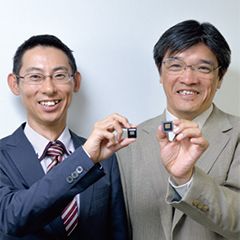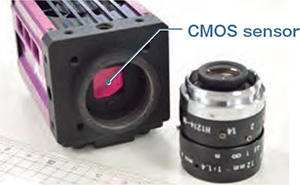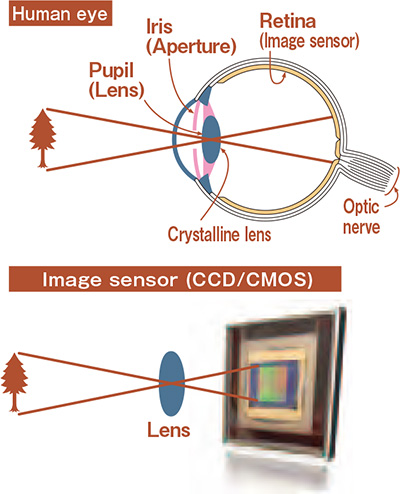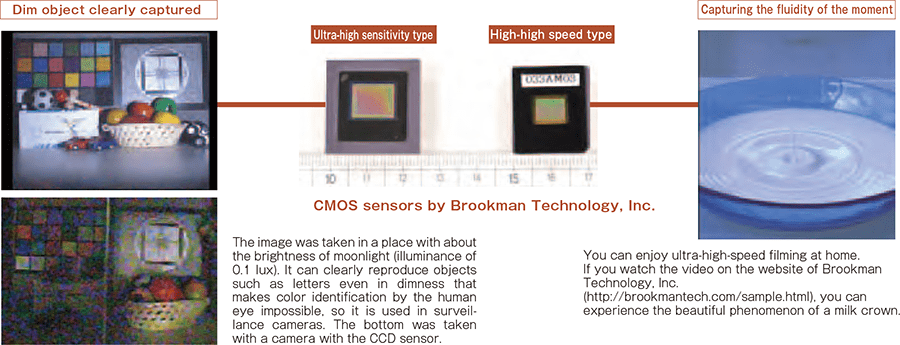Research Results
Super Hi-Vision camera as a surveillance camera and night vision camera
Ultra-high-performance camera with a new image sensor FY2016

- Brookman Technology, Inc. (left: Satoshi Aoyama, President, CEO, right: Shoji Kawahito, Chairman, CTO)
- A-STEP, Full-scale R&D stage
- Practical Development (by SME Start-up)
"Ultra High Sensitivity and High-speed Image Sensor" Developing and implementing company (2009-2012)
Developing the image sensor for the next-generation "Ultra-Compact 8K Super Vision Camera"
The development and wide-spread use of"8K Super Hi-Vision"has been promoted with an eye on the 2020 Tokyo Olympics. This system can produce an ultra-high- definition image that offers 33 million pixels, which is 16 times that of the type of high definition currently used for broadcasting. The 8K Super Hi-Vision is expected to provide an image, even though being two-dimensional, that will make you feel as if you are really there, like what a 3D television can do. An ultra-compact 8K Super Hi- Vision camera has already been developed, and images shot with this camera were presented during the 2014 Soccer World Cup in Brazil. A lot of people were surprised with the technology that reproduced the agile movements of players and vivid colors. It was Brookman Technology, Inc. along with NHK Science & Technology Research Laboratories who developed the CMOS image sensor, which is installed in an ultrahigh- performance camera. The ultra-high-performance camera is expected to play a crucial role in the next-generation image media. Brookman Technology, Inc. is a university-launched venture company established by Professor Shoji Kawahito at the Laboratory for Electronics of Shizuoka University.
CMOS sensor

A high-sensitivity type CMOS sensor attached with a small video camera.
When the lens is removed, you can see the light receiving section just inside.
The "Electronic shutter" and" A/D conversion" technique that corresponds to the retina of a human eye determines the performance of an image sensor.
If the camera is compared to the human eye, the image sensor corresponds to the retina, which changes the light that enters into electric signals. There are two types of image sensors; the CCD and the CMOS.
The CCD carries electric signals one after another in a bucket brigade manner; on the other hand, the CMOS can process electrical signals in a batch, thus having the advantage of processing signals quickly and optimally.
The performance of an image sensor is measured by how it can capture an object with "ultra-high sensitivity" and at "ultra-high speed." Professor Kawahito worked on the development of an "electronic shutter," which plays the role of a shutter in a film camera, and an "A/D conversion," technique that transforms analogue light information into digital light information, with the purpose of enhancing its performance. In order to put that technique into practical use, he established Brookman Technology, Inc. as a university- launched venture company. Their research and development was accelerated after being adopted as part of A-STEP in 2009, and finally they succeeded in the development of the innovative technique and its application.

An image sensor corresponds to the retina of a human eye. It forms the image of an object on the light receiving surface of the sensor and converts the contrast of the light into electrical signals so as to produce a picture image.
Capturing the colors and movement of an object, with a high level of visibility with only the brightness of moonlight
One of the produced is a "CMOS global electronic shutter". Conventionally, a "rolling shutter," whose exposure timing is different for each pixel, was used as an electronic shutter for the CMOS image sensor; therefore when moving images were taken, distortion was found on the screen when they were reproduced. On the other hand, since the global electronic shutter used in a CCD image sensor can perform photographic exposure at one time, it can produce images without distortion; however, when the same shutter is used in the CMOS image sensor, due to the generated noise called"reset noise,"the removal of which is impossible in principle, clear images cannot be obtained. However, the removal of the reset noise was successfully performed by employing their original technology. Thus, the optimum use of a global shutter in the CMOS was made possible.
In addition, they developed an "ultra-high sensitivity and wide dynamic range CMOS image sensor" that incorporates an A/D conversion technique, by which two problems that the conventional CMOS image sensor had were solved at one time: It could not create a clear image at the illuminance of about 1 lux (brightness of a single candle), and its dynamic range (width of the contrast that can be handled) was narrow. They succeeded in capturing the colors and movement of an object clearly, realizing a high level of visibility and creating sharp images even at the illuminance of 0.1 lux (about the brightness of moonlight). For this technique, Brookman Technology, Inc. received the Prize of Smaller Enterprise Agency's Director, the highest award presented by the Resona Foundation for Small and Medium Enterprise Promotion, in 2012.

Awarded the Japan Science and Technology Agency President Award at the first "Award for Academic Startups"
Technologies developed by Brookman Technology, Inc. are already being put to practical use in various ways. They are working on the development of an ultra-compact 8K Super Hi-Vision camera, which was introduced at the beginning of the article, with NHK Science & Technology Research Laboratories and Shizuoka University. Additionally, the ultra-high sensitivity and wide dynamic range CMOS image sensor is used in a surveillance camera or night vision camera for filming TV programs. In recognition of the aforementioned achievements, in 2014, Brookman Technology, Inc. was awarded the Japan Science and Technology Agency President Award of the newly established Award for Academic Startups.
In Hamamatsu, where the company was established, Assistant Professor Kenjiro Takayanagi (at that time) at Hamamatsu Industrial High School, the predecessor of Shizuoka University, succeeded in displaying a clear image of the character"イ"on a Braun tube for the first time in the world. Now, after almost 90 years after that great success, the innovation that evolved from highly original technology is being created in the birthplace of Japan's imaging technology development.
